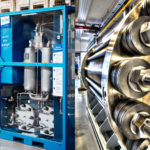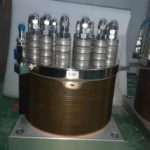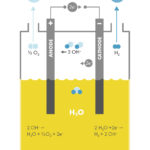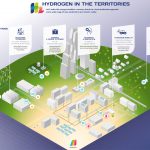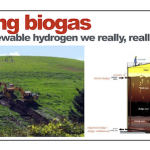Equitex Completes Acquisition of Hydrogen Power, Inc.
Equitex, Inc. (EQTX) announced today that it has completed the acquisition of Hydrogen Power, Inc. ("HPI") through a newly formed Equitex subsidiary which will be the surviving entity and renamed Hydrogen Power, Inc. HPI is now a wholly owned subsidiary of Equitex which controls all of HPI's licensed intellectual property rights to patented hydrogen generation technology in the United States, South America, Mexico and Canada.
Hydrogenics Receives $3.3 Million Order for On-site Hydrogen Generation Plant from Major Energy Company
Hydrogenics Corp (HYGS) announced it was awarded a contract, valued at approximately $3.3 million, to supply a HySTAT(TM)-A Hydrogen Plant to a major North American oil and gas refinery for installation in 2007. The high purity hydrogen generated by the HySTAT-A Hydrogen Plant will be used by the refinery to reduce the sulfur content in diesel fuel in compliance with EPA regulations.
Alkaline Electrolyzers – The Future needs a Metamorphosis
by Ishaan Goel
The second article in this series on water electrolyzers focused on polymer electrolyte membrane electrolyzers (PEMEs). PEMEs have increasingly captured the interest of industry over recent years, due to favorable technical characteristics. Despite this, the global electrolyzer market today is dominated by a much older model - alkaline electrolyzers (ALKEs). (For details of how both electrolyzers work, refer to the first article in the series).
The graph above shows the investment costs ($/kW) of ALKEs and PEMEs as the technology has advanced over time. In other words, they show the initial capital cost for every 1 kW of...
Hydrogen Stocks More Than Double In 2013: Why The Pros Missed The Ride
Tom Konrad CFA Hydrogen Photo via BigStock If you hadn’t noticed that hydrogen stocks are up an average of 131% so far this year, you’re not alone. Both hydrogen fuel cell stocks and hydrogen fuel systems stocks are up strongly. Plug Power (NASD:PLUG), a maker of hydrogen fuel cell systems for off-road vehicles is up 122% year to date. Ballard Power Systems, Inc. (NASD:BLDP), which makes hydrogen fuel systems for a wide variety of applications is up 133% so far this year, and 149% from its...
Twelve Hydrogen And Fuel Cell Stocks
Tom Konrad CFA While many people think first about hydrogen when they think of fuel cells, fuel cells are not limited to hydrogen. They are a set of related technologies, many of which can generate electricity from a number of hydrocarbon fuels rather than hydrogen. I limited my recent post on the rapid rise of hydrogen stocks to just US-listed companies involved in the production and use of hydrogen, leaving out foreign stocks and other fuel cell technologies for brevity. In my research for that article, however, I came across fully ten publicly traded companies involved with...
PEM Electrolyzers – Cracking the Chicken and Egg Problem
by Ishaan Goel
The first article in this series introduced two prominent types of water electrolyzers – alkaline electrolyzers (ALKEs) and polymer electrolyte membrane electrolyzers (PEMEs). Electrolyzers are devices that convert water into hydrogen and oxygen using electricity. They enable energy storage through hydrogen when combined with fuel cells, and can decarbonize hydrogen production for industry if supplied with renewable power. Subsequent articles shall focus on various characteristics of these two electrolyzer variants.
The graph above shows the investment costs ($/kW) of PEMEs and ALKEs as the technology has advanced over time. In other words, they show the initial capital cost...
The Many Shades of Hydrogen
by Ishaan Goel
INTRODUCTION
In 2020, hydrogen shot to the forefront of the renewable energy conversation, with stakeholders making major investments in its growth. The European Union has allocated nearly EUR 400 billion to hydrogen within its Covid-19 recovery package, to ramp up production capacity ~150 times by 2030. Globally, hydrogen production projects under development have nearly tripled (by capacity) with several firms announcing ambitious gigawatt-scaled ventures.
The appeal of hydrogen stems from its excellent capabilities as both an energy carrier and storage medium. Beyond its extensive usage in high-temperature industrial processes and manufacturing, it shows potential in areas that have proven...
Hydrogenics: New Capital, New Orders
by Debra Fiakas CFA Hydrogen technology developer and fuel cell producer Hydrogenics, Inc. (HYGS: Nasdaq) closed out last year ‘following on’ with new capital and new fuel cell orders. The company staged a public sale of its common stock through what is frequently referred to as a ‘follow on’ offering, coming along as this one did some years after the company’s initial public offering. The pricing of these new shares of common stock was ‘followed’ quite closely by announcement of a new order for Hydrogenics fuel cells by a forklift manufacturer in North America. The appearance...
Maxwell Technologies Provides Ultracapacitors for General Hydrogen
Maxwell Technologies (MXWL) announced that General Hydrogen Corporation, a leading developer of hydrogen fuel cell-based power systems for electric forklifts, has placed a 200,000 unit, three-year, purchase order for BOOSTCAP® ultracapacitors to enhance performance and energy management in its Hydricity® Pack technology. The purchase order is part of a strategic supply agreement through which General Hydrogen will source ultracapacitors exclusively from Maxwell and receive strategic pricing if volume thresholds specified in the purchase order are reached.
Introduction to Electrolyzer Technologies
by Ishaan Goel
Hydrogen has become increasingly prominent as a potential carbon-free fuel, for both automobiles and providing electricity to buildings. It has direct applications in decarbonizing important industries like steel, and can serve as a storage medium for extra renewable energy over seasonal durations too.
Since hydrogen gas does not occur naturally in our atmosphere, its method of production is an essential component of the hydrogen economy. There are several such methods (discussed in detail here), but the one with least emissions involves using renewable power to run electrolyzers - devices that use electricity to convert water into hydrogen and...
Hydrogenics Delivers US$ 1.5 million HySTAT Hydrogen Generator to North American Nuclear Power Plant
Hydrogenics Corp (HYGS) announced today that it delivered a HySTAT(TM) Hydrogen Plant in December to a North American nuclear plant. The high-purity hydrogen generated is being used to prevent corrosion and extend the life of stainless steel tubes in the nuclear reactor as part of an upgrade for the purpose of renewing the plant's operating permit. The hydrogen generator in this application consists of two HySTAT-A electrolyzer modules, each capable of producing 33Nm3/hr of hydrogen further demonstrating the scalability of Hydrogenics line of hydrogen generation products.
Beyond ZEVs: The Negative Emission Vehicle
by Jim Lane
Wandering the halls at the BIO World Congress and later to be seen again at ABLC NEXT this November, we ran across one of the most interesting technologies relating to ethanol production and markets we have seen in a month of Sundays, perhaps two months’ worth.
The problem
First, let’s revisit the problem. There’s simply too much ethanol being produced for the markets to absorb, given the Trump Administration’s massive cutbacks in US ethanol targets —In the resulting massively oversupplied market, the inevitable has happened, ethanol producers, growers and the Midwestern economies are being crushed. And they thought they...
List of Hydrogen Stocks
Hydrogen stocks are publicly traded companies whose business involves the use of hydrogen as energy storage or a transportation medium. See also fuel cell stocks.
This list was last updated on 8/27/2021.
AFC Energy (AFC.L)
Ballard Power Corporation (BLDP)
Bloom Energy Corporation (BE)
Cell Impact AB (CI-B.ST)
Defiance Next Gen H2 ETF (HDRO)
FuelCell Energy (FCEL)
Fusion Fuel Green PLC (HTOO)
Green Hydrogen Systems A/S (GREENH.CO)
Hazer Group Limited (HZR.AX)
HydrogenPro AS (HYPRO.OL)
HydroPhi Technologies Group, Inc. (HPTG)
HyperSolar, Inc (HYSR)
Hynion AS (HYN.OL)
ITM Power PLC (ITM.L, ITMPF)
MagneGas Corporation (MNGA)
McPhy Energy SA (MCPHY.PA)
myFC Holding AB (MYFC.ST)
Nel ASA (NEL.OL)
Nikola Corporation (NKLA)
PowerCell Sweden AB (PCELL.ST, PCELF)
Plug Power (PLUG)
PowerHouse Energy Group plc (PHE.L)
Proton Power Systems (PPS.L)
Quantum...
McPhy: Growing With Hydrogen
by Debra Fiakas, CFA
Hydrogen system developer McPhy Energy SA (MCPHY: PA) recently reported impressive sales growth in the first half of 2019 - 23% higher than last year. Sales were boosted by delivery of a refueling station in Houdain, France for a bus operation that is 100% powered by hydrogen. New orders for projects in Germany, Bangladesh and Switzerland will keeps the company busy in the month ahead installing additional hydrogen fueling stations and electrolysis equipment for hydrogen production.
Despite the success, McPhy has not achieved profitability. Thus the company remains dependent upon financing to support operations. In 2017, the company secured an equity sales agreement with Kepler...
There’s Hydrogen In That There Biogas
I don’t suppose that anyone actually dreams of hydrogen, but in the bio-economy there just isn’t quite enough of it and we read about it and sometimes think about it so much that we might as well be dreaming about it.
For those newer to the field, one of the problems of using biomass to make a fuel is that a carbohydrate contains around 53% oxygen by weight and needs about 16% more hydrogen that it contains to make a hydrocarbon fuel. That’s one of the reasons that biofuels are often esters (such as biodiesel) or alcohols (such as ethanol),...
PEM Fuel Cells – Hoping to Challenge Internal Combustion
The first article in this series introduced the two prominent types of hydrogen fuel cells - alkaline fuel cells (ALKFCs) and proton-exchange membrane fuel cells (PEMFCs). Fuel cells are devices that convert stored hydrogen into usable energy, and constitute an essential part of the hydrogen economy. Subsequent articles shall focus on various characteristics of these two cells.
The graph above shows the power costs ($/kW) of PEMFCs and ALKFCs as the technology has advanced over time. In other words, they show the initial capital cost for every 1 kW of fuel cell capacity (note that this axis is in the...

